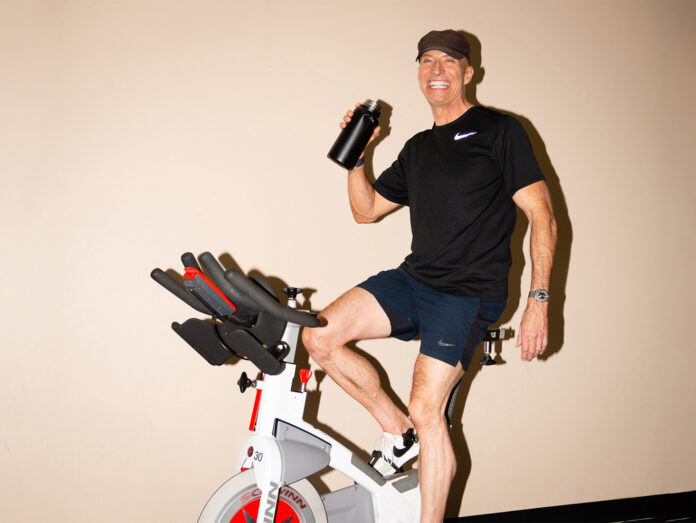This isn’t for everyone. It is what I do, or at least aim to do. The best fitness plan is the one that you will do, and you will enjoy doing. My gym is super social. I know many of the people by name, and we all seem to cheer each other on. It is one of my happy places. Doing a plan like this may seem like a grim chore to some people; to me, it is almost play time. The night before, I already know what I am going to do and am excited to begin. I thrive on tracking all this stuff; it gives me a sense of agency and accomplishment in a larger world that I don’t have much control over. I also feel amazing when I work out and, if I didn’t, I am not sure I would be doing this stuff.
When we think about fitness, there are 4 main pillars: strength, aerobic (cardiovascular capacity), stability, and flexibility. I try to attend to each of these in some form daily, aiming for 7 days a week, but life happens, and I usually end up with 5-6 days a week. My own understanding of aerobic fitness comes from world-renowned conditioning coach Joel Jamieson. I interviewed Joel on the SuperAge podcast, and he’s been tremendously helpful in helping me understand how all the aerobic systems work. Aerobic fitness underlies pretty much everything. If you’re new to fitness, this is where to start. Any effort, with the exception of something like pure powerlifting, and I am guessing there are very few of you who are competitive powerlifters, is mostly aerobic in nature. Even a highly trained athlete can only put out a maximum of 8-10 seconds of full anaerobic output; everything beyond that is, at its foundational level, partially aerobic.
Aerobic fitness underlies pretty much everything
Aerobic fitness is also tied to longevity in the form of lower blood pressure, lower resting heart rate, and higher heart rate variability. Peter Attia feels that VO2 max, the measure of how much oxygen one can utilize during exercise, is a good indicator of future longevity.
The key to any adaptation is gradual, progressive overload. We only adapt during our rest and recovery times, not during the times of exertion. Another thing to keep in mind is to only do the minimum necessary to cause an adaptation; doing any more will only cause needless stress on the body. Understanding what is needed and how that will change based on age, goals, and fitness level is where the wisdom is, but having some tools is helpful.
Taking heart-rate measurements during exercise is vital for successful aerobic training. The optically based wearables — Apple Watch, Garmin, WHOOP, Oura, Fitbit, and others — are great for some things, but tend to lose the plot during high heart-rate exercise. That’s why I employ a chest-based heart-rate monitor. I use a Morpheus, but any of them will work well. The second thing you may want (and this is just for people like me who geek out on this stuff) is a way to measure your morning resting heart rate and heart rate variability. These are both good proxies for fitness level, and for how much strain one is under. For this, I use another of Joel’s Morpheus monitors, but there are many others that work. It just needs to be able to take a snapshot of where you are at the same time every day. If it is an average, or done at random parts of the day, it will not be as useful. These daily metrics let me know if I should back off and have a more restful day or if I am ready to take on more strain. The most important indicator is not the gadgets, but how you feel on any given day. Ask yourself in the morning: what does my body need?
Taking heart-rate measurements during exercise is vital for successful aerobic training
All this assumes that you have checked with a physician to make sure you can handle a program like this. If you are only going to do one part of my program, it would be the long, slow-distance part, the aerobic capacity training. I aim for around 150-250 minutes of this per week, which can be in the form of hiking, bike riding, slow jog or any method you prefer. Aerobic Zone 2 is de-stressing on the body vs high-intensity intervals that put a lot of strain on all the systems of the body.
Here are 3 basic systems that I train: aerobic capacity, mid-level intervals, and high output aerobic power, which line up with most real-world activities.
Monday: Aerobic Capacity. 30-45 minutes of steady state Zone 2.
Tuesday: A. Intervals 6 rounds 1 minute each at the top of Zone 2 for 15 seconds, then bottom of Zone 2 for 45 seconds.
B. Top of Zone 3 (85% -90% Max HR) for 3-5 minutes.
Repeat cycle of A and B for 2 rounds.
Weds: 30 minutes Zone 2 steady state.
Thursday: 15 rounds of 1 minute top of Zone 2, 1 minute bottom of Zone 2.
Friday: 15 minutes Zone 2, then 4 rounds of maximum output for whatever time you can — maybe 8 sec, maybe 30 seconds followed by 3 minutes of Zone 2 recovery. This is all-out effort and you may be hitting close to your maximum heart rate. Let’s be real: these max heart-rate efforts are no fun.
Saturday. 20 minutes of Zone 2 steady state.
Sunday: Hike in nature, swim with friends, or similar.
As you train more, you can increase the volume of very high intensity, but keep in mind that even elite athletes will only train at those levels twice a week. These workouts will increase one’s VO2 max, but are extremely stressful on the body and should always be followed by 1 or 2 days of recovery de-stressing workouts, which is what a Zone 2 steady state round will do. After finishing any high output workout, make an effort to bring your body back down into recovery mode. For me, this is 3 minutes of gently riding on a bike followed by 5 minutes of lying on my back with my eyes closed, listening to relaxing music and practicing a down-regulating breathwork like box breathing. I have learned that not only can fitness be improved from training, so can my ability to speedily recover.
If all this sounds daunting, I get it. As I said in the beginning, it is not for everyone; however, some form of aerobic fitness is for everyone. Maybe you get most of your exercise playing a sport: soccer, tennis, swimming, racketball, mountain biking, vigorous hiking, or dancing. Surprising fact: I love dancing and studied African dance in NYC for 5 years. Any activity is better than no activity, although there are days when we all just need to lie down and rest. If you can, it is a good idea to challenge your body on a regular basis because, as we age, if we are not making an effort to improve our fitness we will be declining. Take it from me: getting it back is harder than staying on top of it.




Short periods of high intensity are more beneficial than 20-30 min of zone 2. Sprint interval training also builds strength, healthy hormones, and cardio … all in one. http://sprintforever.blogspot.com/